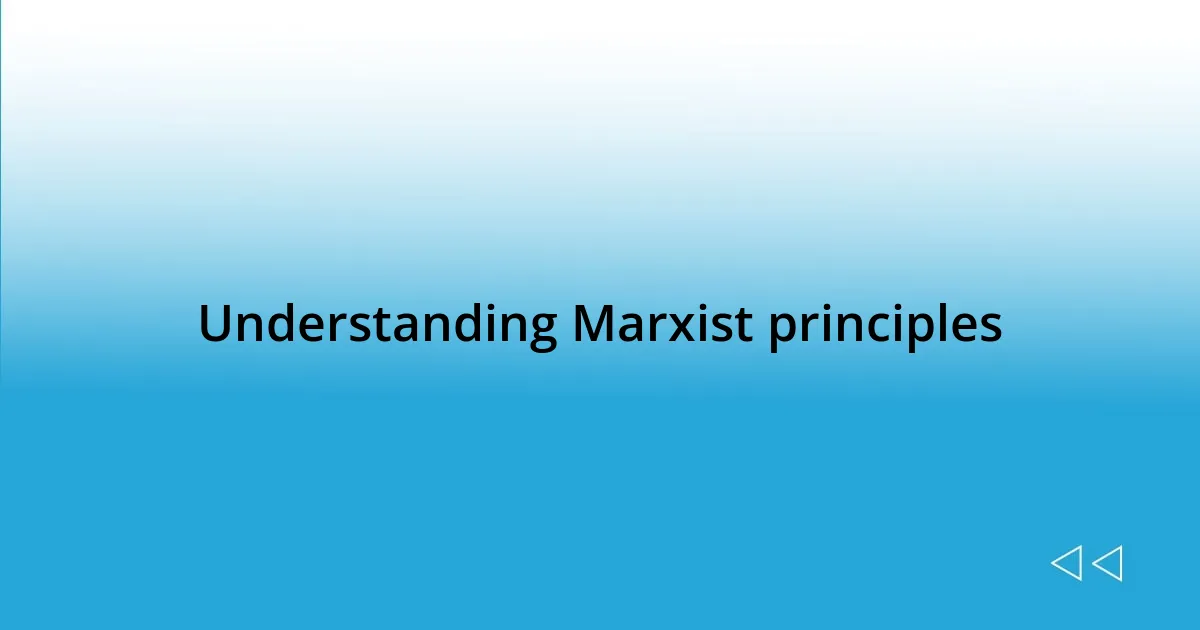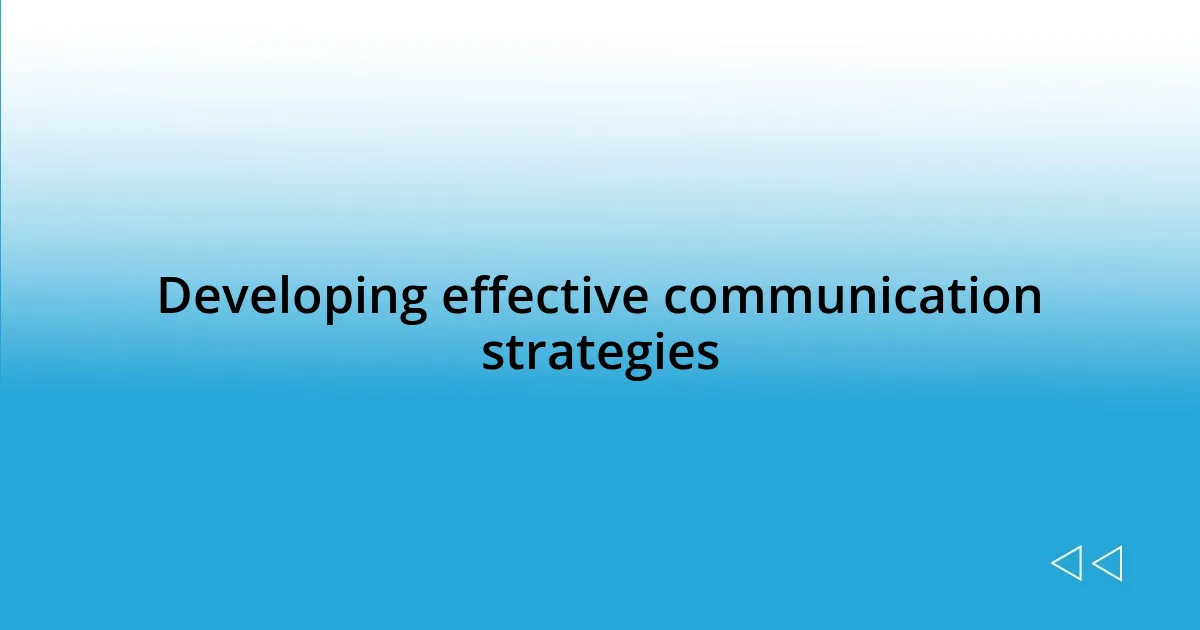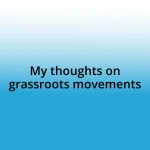Key takeaways:
- Marxist principles emphasize class struggle, critiquing capitalism for exploitation and alienation while inspiring collective action for social equity.
- Key social issues such as income inequality, racial injustice, environmental degradation, and labor exploitation need urgent attention within Marxist activism.
- Building community networks fosters trust, inclusivity, and collective empowerment, reinforcing the idea that individual struggles are part of a larger narrative.
- Utilizing digital tools for activism enhances message amplification and engagement, allowing for broader participation and connection across diverse communities.

Understanding Marxist principles
Marxist principles revolve around the idea that history is driven by class struggle. I remember reading “The Communist Manifesto” for the first time; it ignited a spark in me as I realized the power dynamics at play in our society. Reflecting on my own experiences, I often found myself questioning, why do some people control resources while others struggle to meet basic needs? This is precisely the imbalance Marx sought to expose.
At its core, Marxism critiques capitalism, highlighting how it can lead to exploitation and alienation. I’ve felt that alienation personally in jobs that drained my energy yet offered little fulfillment. It prompts me to consider, how often do we trade our time and talent for mere survival, rather than growth or passion?
Engaging with these concepts isn’t just theoretical; it’s a call to action. When I discuss Marxist ideas with friends, we often grapple with questions about solidarity and collective action. How can we support one another in this struggle? Every discussion deepens my understanding and commitment to fostering a more equitable society.

Identifying key social issues
Identifying key social issues is essential for effective Marxist activism. I’ve found that diving into conversations with diverse communities uncovers layers of struggles that often go unnoticed. For instance, during a local neighborhood meeting, I heard powerful stories about members fighting against gentrification that threatened their homes. It hit me that these issues are not just statistics; they affect real lives and deserve our urgent attention.
Here are some crucial social issues that often emerge in Marxist discussions:
- Income inequality: The gap between the wealthy and the working class continues to widen, affecting opportunities for many.
- Racial injustice: Systemic racism exacerbates economic disparities, making it crucial to address these intertwined issues.
- Environmental degradation: Capitalist practices often prioritize profit over the planet, leading to devastating consequences for marginalized communities.
- Labor exploitation: Many workers face unfair wages and unsafe conditions, reminding us of the need for solidarity in the workforce.
In recognizing these issues, I feel a deeper sense of responsibility to not only understand them but to actively engage in the fight for change. Each story shared, each struggle highlighted, strengthens the collective voice in this movement.

Building community networks
Building community networks is a cornerstone of effective Marxist activism. I recall a time when I collaborated with a local community group focused on mutual aid, sharing resources like food and clothing. It struck me how these simple acts of solidarity can bridge gaps between people, creating a sense of belonging and empowerment. Through these connections, we learned that our individual struggles were part of a larger narrative, inviting a supportive environment for collective action.
In my experience, fostering trust and open communication within these networks is essential. I remember a workshop where we discussed strategies to enhance participation. Someone shared their concerns about feeling unheard in traditional spaces, and it resonated deeply with me. It became clear that by creating safe spaces for dialogue, we amplify marginal voices and foster inclusivity, which ultimately strengthens our collective power.
A community network thrives not just on shared goals but on shared values. I’ll never forget a potluck dinner we hosted, bringing together diverse groups to celebrate our cultures. The warmth and acceptance filled the room, and I realized that these relationships go beyond activism; they nurture friendships that inspire sustained commitment to our cause. This leads me to reflect—how often do we prioritize connection in our activism? It’s essential, and it’s what keeps the fire of our movement alive.
| Strategy | Benefit |
|---|---|
| Mutual Aid Initiatives | Encourages resource sharing and community support |
| Building Trust | Fosters open dialogue and inclusive participation |
| Cultural Celebrations | Nurtures relationships and sustained commitment |

Engaging in grassroots organizing
Engaging in grassroots organizing has taught me that the power of the people is truly remarkable. I remember mobilizing my neighbors to protest against a zoning law that threatened our community park. The energy was palpable; as we marched together, I realized that collective action not only raises awareness but also strengthens the bonds within our community. Have you ever felt the adrenaline of standing alongside people who share your vision for change? It’s an experience that reinforces the sense of belonging and purpose.
I’ve found that effective grassroots organizing involves listening as much as leading. At a recent planning meeting, one member shared their experience of feeling powerless against corporate interests. In that moment, it hit me how crucial it is to create spaces where everyone feels valued and heard. By integrating their story into our strategy, we framed our fight against corporate development as not just a political battle but a deeply personal one. How often do we overlook the voices that could significantly impact our movement? It’s a reminder that every individual’s narrative can shape our collective story.
Moreover, the importance of follow-up cannot be overstated in grassroots organizing. After our initial success in halting the zoning changes, we held community reflection sessions to celebrate and assess what we achieved. These gatherings sparked new ideas and inspired a renewed commitment to ongoing issues—like environmental justice—which had surfaced in our discussions. I often ponder how our past victories can fuel future activism. Are we harnessing that energy effectively? Reflecting on these experiences keeps me motivated, fostering a continuous loop of engagement and action that powers the movement forward.

Developing effective communication strategies
Developing effective communication strategies is crucial in amplifying our message. During a campaign meeting, I once suggested we utilize social media to share personal stories from our community members about the impact of local policies. The minute we started posting these testimonials, we noticed an increase in engagement. It made me wonder—how often do we underestimate the power of personal narratives in our activism?
In my experience, clarity and consistency in messaging are paramount. I’ll never forget a time when we struggled to convey our stance at a protest. Mixed signals resulted in confusion among supporters and detractors alike. By refining our key messages and ensuring everyone was on the same page, we turned things around. It’s essential to ask ourselves: how streamlined is our communication? Effective messaging can transform confusion into clarity and galvanize support for our cause.
Furthermore, incorporating feedback loops can significantly enhance our strategies. After an event, I always encourage participants to share their thoughts, even if it’s just a quick chat over coffee. It was during one of these informal discussions that a participant pointed out how different age groups interpret our messages. This insight opened our eyes to the need for tailored communication. So, how often do we actively seek out these valuable perspectives? Engaging with our community in this way fosters not only improvement but a deeper connection with those we seek to empower.

Utilizing digital activism tools
Utilizing digital activism tools has become a game-changer in my experience of Marxist activism. I remember when we launched an online petition to demand affordable housing in our city. The excitement of watching signatures pour in from individuals I’d never met was invigorating. It struck me: how often do we realize that a simple click can be a profound act of solidarity and change?
Social media platforms serve as powerful amplifiers for our causes. I’ve frequently shared live updates from protests or community events, and each time, the responses flooded in. People from various backgrounds reaching out to express solidarity or share their own stories made me pause. Have you ever felt the rush of connection that comes from instant engagement? It reinforces the idea that we’re part of a much larger movement, transcending geographic barriers.
Moreover, creating and sharing multimedia content—like short videos or infographics—has proven invaluable in educating and mobilizing supporters. I vividly recall crafting a video that explained the principles of cooperative economics, which not only went viral but sparked discussions in online forums. It made me think, how effective can our messaging be when we harness the creativity of digital tools? This experience reminded me of the endless possibilities that digital activism offers in shaping public discourse and energizing our collective efforts.

Measuring impact and outcomes
Measuring impact and outcomes in our activism is essential for understanding how our efforts resonate within the community. I remember a time we organized a workshop aimed at raising awareness about workers’ rights. Afterward, we distributed a simple survey to attendees to gauge what they learned. The results surprised me—many had never understood their rights before. Isn’t it incredible how a few hours of dialogue can profoundly shift someone’s perspective?
One of the most enlightening metrics I’ve used involves tracking engagement levels on our online platforms. I once compared the before-and-after results of our campaigns and noticed a sharp increase in followers and shares whenever we successfully highlighted a local initiative. This led me to question: how can we continuously iterate our efforts to build on this momentum? I learned that measuring outcomes goes beyond just numbers; the genuine connections we make and the conversations we spark can sometimes be the most significant indicators of our impact.
Ultimately, using qualitative data often reveals deeper truths than statistics alone. When we conducted follow-up interviews with participants from our community outreach, the stories they shared conveyed emotional resonances that metrics simply couldn’t capture. One participant spoke about how attending our meeting inspired him to fight for better wages for his coworkers, and that moment solidified for me the true power of our work. How often do we forget the stories behind the numbers? By bringing those narratives into our assessments, we can truly understand the change we’re fostering.
















